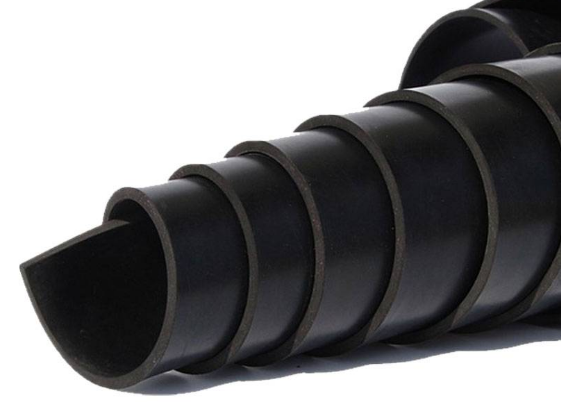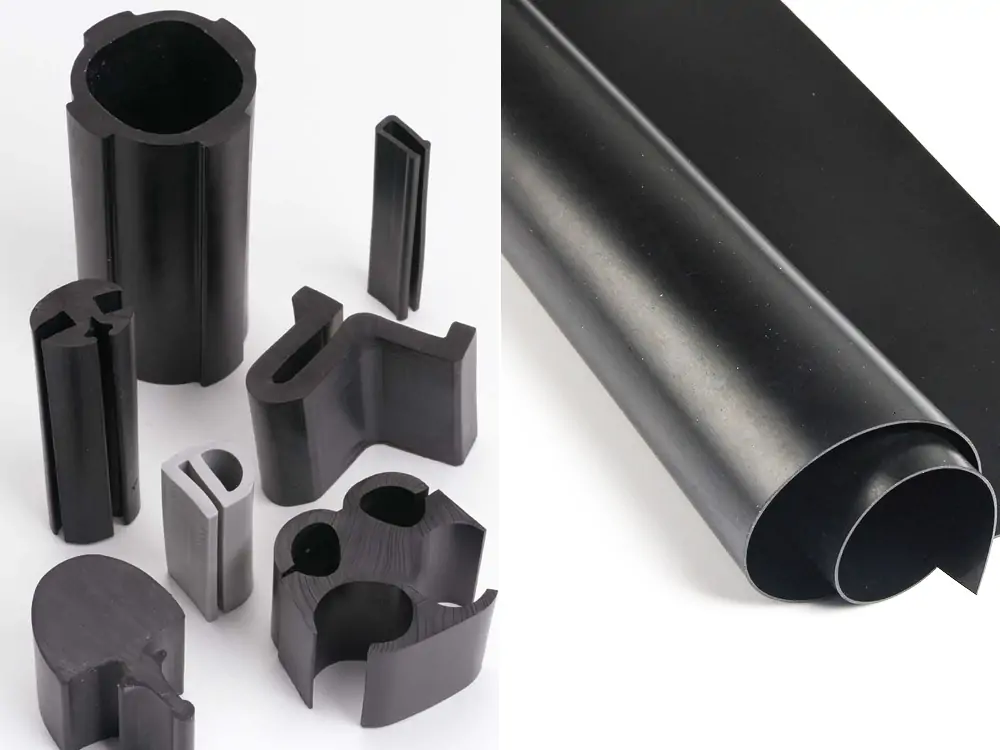We all are very much aware of the various uses of elastomers in different applications. You know, they play a crucial role in sealing and cushioning services. When considering these uses, elastomers may require additional properties and performance. Thus, various types of elastomers are born from these diverse uses. Well-known rubber materials include EPDM, nitrile, neoprene, FKM, and Viton. Well, NBR & HNBR are also famous for their unique properties. Therefore, it is essential to identify the fundamental differences between them (NBR vs HNBR).
Throughout this article, we will distinguish between NBR & HNBR by their different abilities. In this case, we will consider a few criteria. They include temperature, chemical, tensile strength, wear & abrasion resistance, and cost. In the end, you can choose the suitable material for your project. So, no more intro. Let’s dig in.
What is NBR?
NBR stands for Nitrile Butadiene Rubber. It is a synthetic rubber copolymer made from acrylonitrile(ACN) & butadiene. Combining these two materials forms an excellent elastomer known as NBR rubber. NBR is typically well-known for its superb oil resistance abilities. It has excellent resistance to oils, fuels, and greases. As a result, they are ideal for applications where contact with these substances is common. Besides this characteristic, NBR rubber is also famous for the following properties.
- They are highly flexible & durable. As a result, they offer high tensile strength and abrasion resistance.
- NBR rubber performs well across a broad temperature range. We can realize that it can maintain its properties in both high & low temperatures.
- Besides oil or fuel, NBR rubber is excellent in chemical resistance. They provide satisfactory resistance to a variety of chemicals.
- NBR rubber also offers excellent capabilities.
Well, we will highlight the specific values of each property in the comparison section. Before that, let’s check NBR rubber’s popular application fields. The automotive industry uses NBR rubber as seals, gaskets, and hoses. On the other hand, in the oil & gas industry, they are prevalent in various hydraulic systems. Besides, NBR rubber seal strips can also be found in aerospace, medical, industrial machinery, and consumer goods.

What is HNBR?
HNBR stands for Hydrogenated Nitrile Butadiene Rubber. It is a particular type of NBR rubber. What sets HNBR apart from NBR is the additional step of hydrogenation. HNBR rubber is produced by introducing hydrogen into the saturation of NBR. Compared to NBR rubber, it provides enhanced properties. Let’s check them out.
- HNBR rubber is famous for its premium-grade material due to its superior properties. Although, compared to NBR, HNBR is expensive. Conversely, they are ideal for various critical applications.
- It exhibits superior temperature resistance compared to NBR. The hydrogenation process technically impacts increased thermal stability.
- The hydrogenation process also enhances HNBR’s chemical resistance ability. Although, aromatic oils and polar organic solvents may easily damage it.
- HNBR rubber exhibits a low compression set. It maintains its shape and sealing properties even after prolonged compression periods.
Well, we will highlight the specific values of each property in the comparison section. Before that, let’s check HNBR rubber’s application fields. HNBR rubber sheets are commonly used in various industries. It is prevalent in aerospace, automotive, oil drilling, machinery manufacturing, and chemical industries. Therefore, it is prevalent where oil & gas contact is required.

What is The Difference Between NBR And HNBR?
Both NBR & HNBR are popular in critical applications. Well, the specific use may depend on particular application requirements. In the following table, we have generalized the comparison between these two elastomers. The particular formulation of NBR & HNBR depends on manufacturers and applications. You can check this table to understand the difference between NBR and HNBR quickly.
Table 1 NBR vs HNBR Comparison Table
| Property | NBR | HNBR |
| Chemical Structure | Copolymer of Butadiene and Acrylonitrile | Hydrogenated form of NBR |
| Temperature Resistance | Moderate temperature resistance (-30°C (-22°F) to +100°C (212°F)) | Enhanced temperature resistance, higher working temperature range -60°C (-76°F) or up to +160°C (320°F) |
| Chemical resistance | Good resistance to oils and fuels | Improved resistance to chemicals, ozone, and harsh environments. Although |
| Tensile Strength | Moderate tensile strength (200 – 3,500 PSI) | Higher tensile strength, better mechanical properties (1,500 – 3,500 PSI) |
| Wear & Abrasion Resistance | Good resistance to wear & abrasion | Improved resistance to wear & abrasion |
| Cost | Generally lower than HNBR | Higher cost due to additional manufacturing process |
| Application | Automotive seals, gaskets, hoses | Rubber sheets in aerospace, automotive, oil drilling, chemical industry and many more |
NBR vs. HNBR: Temperature Resistance
Both NBR & HNBR offer excellent temperature resistance properties. In NBR’s chemical structure, the copolymer of butadiene & acrylonitrile influences its thermal characteristics. NBR rubber can generally withstand the temperature range from -30°C (-22°F) to +100°C (212°F). As a result, These seal strips are popular for moderate-temperature applications.
Conversely, in HNBR’s chemical structure, the saturated hydrocarbon typically influences its thermal characteristics. Well, the hydrogenation process in HNBR enhances its thermal stability. This rubber material can withstand temperatures ranging from -60°C (-76°F) or up to +160°C (320°F). This improved resilience makes it ideal for various heat exposure applications.
NBR vs HNBR: Chemical Resistance
Chemical resistance is a critical parameter in various sealing applications. You know, NBR is primarily known for its excellent resistance to different chemicals. The saturation of the polymer backbone is the reason for this superb chemical resilience property. As a result, NBR is less susceptible to attack by various chemicals.
On the other hand, HNBR rubber exhibits enhanced chemical resistance due to its hydrogenation process. This modification introduces additional cross-links in the polymer structure. As a result, HNBR rubber is more resistant to a broader range of chemicals. Famous examples include acids, bases, and various solutions. Although, aromatic oils and polar organic solvents may easily damage it.
NBR vs HNBR: Tensile Strength
Tensile strength is a material property that determines a material’s resistance to being stretched apart by a force. Concerning NBR, the tensile strength is enhanced by its molecular structure. Therefore, NBR rubber is highly suitable for sealing & gasket applications in various settings. Well, compared to HNBR, NBR may have less tensile strength. The tensile strength ranges from 200 – 3,500 PSI.
HNBR, on the other hand, boasts superior tensile strength than NBR rubber. The hydrogenation process enhances the polymer matrix. As a result, HNBR rubber comes with increased strength & durability. It makes HNBR suitable for demanding applications where tensile strength is a concern. Well, the tensile strength of HNBR ranges from 1,500 – 3,500 PSI.
NBR vs HNBR: Wear & Abrasion Resistance
Due to friction or rubbing during contact with another surface, a material may lose some of its parts. The ability to withstand this loss is technically the material’s wear resistance. On the other hand, abrasion resistance is closely related to wear resistance. It mainly focuses on a material’s ability to withstand the wearing effects of abrasive particles.
Both NBR & HNBR offer excellent wear & abrasion resistance. Well, HNBR offers enhanced wear & abrasion resistance than NBR. You know, the hydrogenation typically enhances the polymer structure. Therefore, HNBR is more durable and resilient against abrasive forces.
NBR vs HNBR: Cost
Cost is another crucial factor to consider, depending on your investment. NBR is generally known for its cost-effectiveness. Therefore, we often find it in various industries where budget constraints are a significant concern. It makes an attractive option for applications that do not demand enhanced properties.
On the other hand, HNBR is more expensive than NBR due to its additional manufacturing process. In most cases, if the specific application doesn’t require enhanced properties, HNBR may not be suitable. Therefore, the decision between NBR & HNBR involves the project’s budget against performance requirements.

NBR vs HNBR: Which is Right For Your Project?
As mentioned, both NBR & HNBR are widely popular in various applications. The choice between these two rubber materials depends on considering multiple factors. Considering these factors, you can ensure your application’s optimal performance and longevity.
Tip 1: Consider Your Application Requirements
To make the right decision, evaluate your application’s specific demands. You can check the temperature, chemical exposure, mechanical stress, and environmental factors.
Tip 2: Choose The Suitable Materials for The Evaluated Application Requirements
Check the compatibility of the NBR or HNBR grades against your application requirements. In this case, evaluate the resistance of these materials against various criteria we discussed above. In addition, balance the cost against the efficiency and performance of your application.
Tip 3: Seek Professional Assistance
You can also consult with professionals or reach out to our customer support. Professionals can provide you with sufficient knowledge to help you make informed decisions.
Conclusion
Let’s wrap everything up! NBR stands for Nitrile Butadiene Rubber. Consequently, the additional stage of hydrogenation creates the HNBR rubber. Well, this hydrogenation process typically enhances the overall performance of HNBR. It ultimately becomes a superior choice against NBR. However, this additional manufacturing process ultimately increases HNBR’s overall production cost.
While choosing the suitable material for your project, it is essential to consider a few factors.
- First, temperature resistance determines the ability of the rubber to withstand certain temperatures.
- Second, tensile strength defines the ability of the rubber to withstand specific stress forces.
- Third, wear & abrasion resistance determines the ability to withstand friction.
- Fourth, chemical resistance determines the ability to withstand certain chemicals.
- Finally, cost consideration determines the suitability of the materials against your project’s performance.
